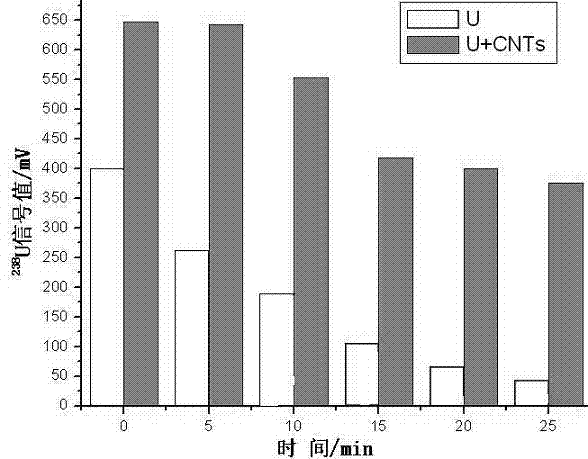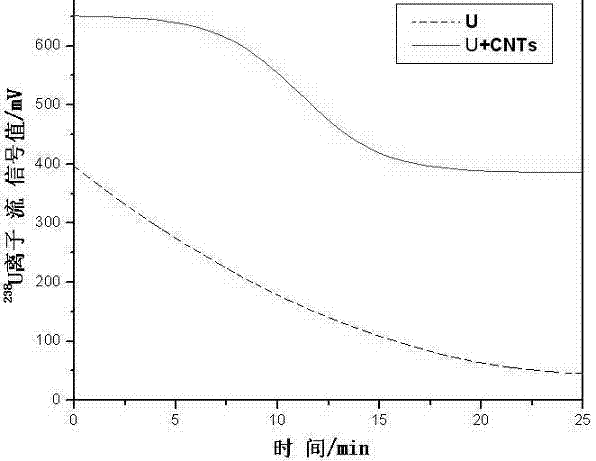Uranium isotope abundance measurement method by using carbon nanotubes as ion emission agent
A technology of isotopic abundance and carbon nanotubes, which is used in measurement devices, preparation of samples for testing, and material analysis by electromagnetic means. The effect of increased efficiency, reduced coating volume, and improved stability
- Summary
- Abstract
- Description
- Claims
- Application Information
AI Technical Summary
Problems solved by technology
Method used
Image
Examples
Embodiment 1
[0023] The measurement method disclosed in the present invention is mainly composed of three major steps of sample preparation, sample coating and sample measurement, and the three steps are now described in detail.
[0024] (1) Sample preparation: including the preparation of carbon nanotube suspension and the pretreatment of rhenium tape, among which:
[0025] Preparation of carbon nanotube suspension: Weigh three parts of 0.1g carbon nanotubes into 100ml plastic bottles, add 50ml deionized water with a resistivity >18MΩ.cm, and ultrasonically disperse for 20 minutes to form a uniform suspension Standby, if it has not been used for a long time, it needs to be ultrasonically dispersed before use.
[0026] Pretreatment of rhenium ribbons: (a) Degassing treatment: Degas the rhenium-rhenium double-belt inserts in the degassing device to remove moisture and impurities. Combined composition, its size is 0.04×0.7×18mm, the evaporation rhenium belt is used to provide the evaporatio...
Embodiment 2
[0040] The only difference between this example and Example 1 is that in step (2) of this example, the carbonized evaporated rhenium strip is placed on the applicator, and 1 μL of uranium solution is dropped on the sample applicator with a micropipette. In the center of the evaporated rhenium band, slowly increase the temperature of the evaporated rhenium band to 300°C and dry it, then disconnect the current, wait until the evaporated rhenium band drops to room temperature, take 1 μL of carbon nanotube suspension and coat it on the uranium sample, slowly raise Evaporate the rhenium strip at 180°C to dry a large amount of water, then raise it to 300°C for drying, and finally raise it to 400°C for 10 seconds, disconnect the current, take the sample strip down to room temperature, and put it on the sample together with the ionization strip On the turntable to be tested.
[0041] In step (3), put the installed turntable into the ion source, turn on the mass spectrometer, and perfo...
Embodiment 3
[0044] The only difference between this example and Example 1 is that in step (2) of this example, the carbonized evaporated rhenium strip is placed on the applicator, and 1 μL of uranium solution is dropped on the sample applicator with a micropipette. In the center of the evaporated rhenium band, slowly increase the temperature of the evaporated rhenium band to 350°C and dry it, then disconnect the current, wait until the evaporated rhenium band drops to room temperature, take 1 μL of carbon nanotube suspension and coat it on the uranium sample, slowly raise Evaporate the rhenium tape at 220°C to dry a large amount of water, then raise it to 350°C for drying, and finally raise it to 450°C for 20 seconds, disconnect the current, take the sample tape down to room temperature, and put it on the sample together with the ionization tape On the turntable to be tested.
[0045] In step (3), put the installed turntable into the ion source, turn on the mass spectrometer, and perform ...
PUM
 Login to View More
Login to View More Abstract
Description
Claims
Application Information
 Login to View More
Login to View More - R&D
- Intellectual Property
- Life Sciences
- Materials
- Tech Scout
- Unparalleled Data Quality
- Higher Quality Content
- 60% Fewer Hallucinations
Browse by: Latest US Patents, China's latest patents, Technical Efficacy Thesaurus, Application Domain, Technology Topic, Popular Technical Reports.
© 2025 PatSnap. All rights reserved.Legal|Privacy policy|Modern Slavery Act Transparency Statement|Sitemap|About US| Contact US: help@patsnap.com


